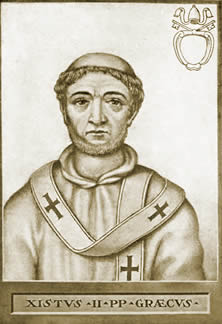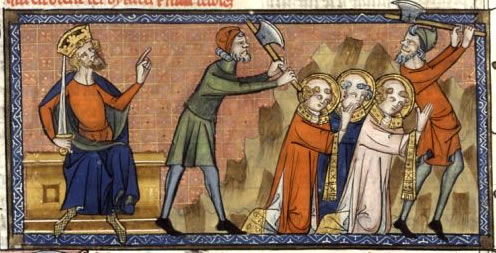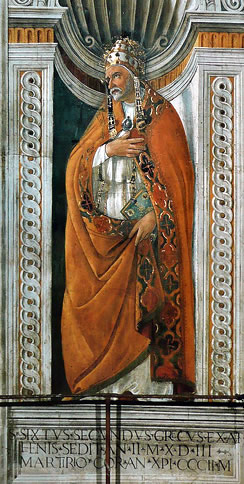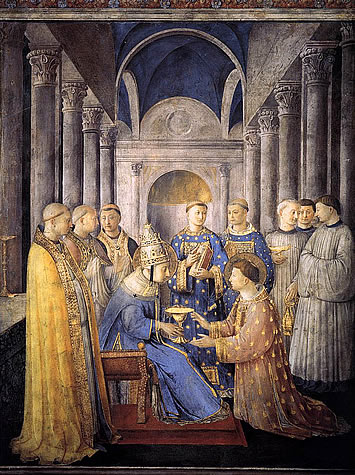| Raphael's
Masterpieces |
|
Pope
Sixtus II |
||
|
Bio
Pope St. Sixtus II from Catholic Encyclopedia |
Bio
Pope St. Sixtus II from New World Encyclopedia |
How
many fingers on the right hand of the Pope Sixtus II? |
 |
| Raphael
Sanzio (Santi) Oil
on canvas |
•
He is staring at Madonna and Christ in surprise. |
| Holy
Sixtus II |
||
 Holy Sixtus II |
Born
in the early third century, Sixtus lived in a time of many changes
in the Roman Empire.
In 257, Emperor Valerian issued a decree, which mandated Christian clergymen sacrifice to the pagan gods or die. As a result, many Christians were put to death, including Pope Steven I. Sixtus was then secretly consecrated as Steven's successor. One of Sixtus's important contributions as Pope was to make peace with the Churches in Asia Minor and northern Africa, where some bishops held that baptisms conferred by heretics were not valid, in contradiction to Church policy in Rome. His predecessor had been stern in trying to correct these bishops, but Sixtus was loving, and he managed to restore friendly relations. Soon after Sixtus became Pope, Emperor Valerian issued an even stronger decree against Christians, ordering the execution of all Christian clergymen. On August 6, 258, Sixtus was addressing the congregation at a liturgical service in the private cemetery of Praextextatus, which was believed to be a safe haven. Suddenly, imperial forces rushed in and seized the Pope. It is said that Sixtus refused to attempt an escape, even when the opportunity presented itself, for fear of initiating a massacre of the congregation. Instead, he was either beheaded immediately or take to court for sentencing and then brought back and executed. He was buried across the road in the Cemetery of St. Callistus. One of the Church's most highly venerated martyrs, Sixtus is the subject of a very famous painting, Raphael's Sistine Madonna, also called Our Lady and Child with SS Sixtus II and Barbara. |
|
St. Sixtus II and companions Even as the storm of persecution created by Emperor Valerian raged against the Church, the papal throne was not vacant. Sixtus, a Greek, was elected to succeed Stephen. The emperor's decrees had ordered the Christians to take part in state religious ceremonies and forbade them to assemble in cemeteries. For nearly a year Sixtus managed to evade the authorities before he was gloriously martyred. Valerian issued his second edict ordering the execution of Christian bishops, priests, and deacons. Sixtus had taken to holding services in the private cemetery of Praetextatus because it was not watched as closely by the authorities as was the cemetery of Calixtus. But in early August of 258, while Sixtus was seated on his episcopal chair and surrounded by the brethren, the soldiers broke in arresting Sixtus and four deacons who were in attendance. |
 The martyrdom of Pope St. Sixtus II and his companions (deacons). French manuscript from the 14th century |
After
a formal judgment, Sixtus was led back to the very place where he
had been arrested, to face execution. His chief deacon Lawrence,
upon hearing the news, hastened to his side, desiring to die with
his bishop. Sixtus consoled his deacon by telling him that he would
follow in three days with even greater glory. The soldiers then
placed Sixtus in his chair and swiftly beheaded him. True to the
great pope's words, Lawrence was arrested three days later and executed
the same day. |
Pope
St. Sixtus II (XYSTUS) Elected 31 Aug., 257, martyred at Rome, 6 Aug., 258. His origin is unknown. The "Liber Pontificalis" says that he was a Greek by birth, but this is probably a mistake, originating from the false assumption that he was identical with a Greek philosopher of the same name, who was the author of the so-called "Sentences" of Xystus. During the pontificate of his predecessor, St. Stephen, a sharp dispute had arisen between Rome and the African and Asiatic Churches, concerning the rebaptism of heretics, which had threatened to end in a complete rupture between Rome and the Churches of Africa and Asia Minor (see SAINT CYPRIAN OF CARTHAGE). Sixtus II, whom Pontius (Vita Cyprian, cap. xiv) styles a good and peaceful priest (bonus et pacificus sacerdos), was more conciliatory than St. Stephen and restored friendly relations with these Churches, though, like his predecessor, he upheld the Roman usage of not rebaptizing heretics. |
Shortly before the pontificate of Sixtus II the Emperor Valerian issued his first edict of persecution, which made it binding upon the Christians to participate in the national cult of the pagan gods and forbade them to assemble in the cemeteries, threatening with exile or death whomsoever was found to disobey the order. In some way or other, Sixtus II managed to perform his functions as chief pastor of the Christians without being molested by those who were charged with the execution of the imperial edict. But during the first days of August, 258, the emperor issued a new and far more cruel edict against the Christians, the import of which has been preserved in a letter of St. Cyprian to Successus, the Bishop of Abbir Germaniciana (Ep. lxxx). It ordered bishops, priests, and deacons to be summarily put to death ("episcopi et presbyteri et diacones incontinenti animadvertantur"). Sixtus II was one of the first to fall a victim to this imperial enactment ("Xistum in cimiterio animadversum sciatis VIII. id. Augusti et cum eo diacones quattuor"—Cyprian, Ep. lxxx). In order to escape the vigilance of the imperial officers he assembled his flock on 6 August at one of the less-known cemeteries, that of Prætextatus, on the left side of the Appian Way, nearly opposite the cemetery of St. Callistus. While seated on his chair in the act of addressing his flock he was suddenly apprehended by a band of soldiers. There is some doubt whether he was beheaded forthwith, or was first brought before a tribunal to receive his sentence and then led back to the cemetery for execution. The latter opinion seems to be the more probable. The inscription which Pope Damasus (366-84) placed on his tomb in the cemetery of St. Callistus may be interpreted in either sense. The entire inscription is to be found in the works of St. Damasus (P.L., XIII, 383-4, where it is wrongly supposed to be an epitaph for Pope Stephen I), and a few fragments of it were discovered at the tomb itself by de Rossi (Inscr. Christ., II, 108). The "Liber Pontificalis" mentions that he was led away to offer sacrifice to the gods ("ductus ut sacrificaret demoniis"—I, 155). St. Cyprian states in the above-named letter, which was written at the latest one month after the martyrdom of Sixtus, that "the prefects of the City were daily urging the persecution in order that, if any were brought before them, they might be punished and their property confiscated". The pathetic meeting between St. Sixtus II and St. Lawrence, as the former was being led to execution, of which mention is made in the unauthentic "Acts of St. Lawrence" as well as by St. Ambrose (Officiorum, lib. I, c. xli, and lib. II, c. xxviii) and the poet Prudentius (Peristephanon, II), is probably a mere legend. Entirely contrary to truth is the statement of Prudentius (ibid., lines 23-26) that Sixtus II suffered martyrdom on the cross, unless by an unnatural trope the poet uses the specific word cross ("Jam Xystus adfixus cruci") for martyrdom in general, as Duchesne and Allard (see below) suggest. |
 St Sixtus II by BOTTICELLI, Sandro, 1481 Fresco, 210 x 80 cm Cappella Sistina, Vatican |
Four deacons, Januarius, Vincentius, Magnus, and Stephanus, were apprehended with Sixtus and beheaded with him at the same cemetery. Two other deacons, Felicissimus and Agapitus, suffered martyrdom on the same day. The feast of St. Sixtus II and these six deacons is celebrated on 6 August, the day of their martyrdom. The remains of Sixtus were transferred by the Christians to the papal crypt in the neighbouring cemetery of St. Callistus. Behind his tomb was enshrined the bloodstained chair on which he had been beheaded. An oratory (Oratorium Xysti) was erected above the cemetery of St. Prætextatus, at the spot where he was martyred, and was still visited by pilgrims of the seventh and the eighth century. For
some time Sixtus II was believed to be the author of the so-called
"Sentences", or "Ring of Sixtus", originally
written by a Pythagorean philosopher and in the second century revised
by a Christian. This error arose because in his introduction to
a Latin translation of these "Sentences". Rufinus ascribes
them to Sixtus of Rome, bishop and martyr. It is certain that Pope
Sixtus II is not their author (see Conybeare, "The Ring of
Pope Xystus now first rendered into English, with an historical
and critical commentary", London, 1910). Harnack (Texte und
Untersuchungen zur altchrist. Literatur, XIII, XX) ascribes to him
the treatise "Ad Novatianum", but his opinion has been
generally rejected. |
| |
Pope
Sixtus II Pope Saint Sixtus II (also called Xystus, meaning "polished") was bishop of Rome from August 30, 257 to August 6, 258. He died a brutal death as a martyr during the persecution of Christians by Emperor Valerian. According to the Liber Pontificalis, Sixtus was Greek by birth, although this is now disputed, since the authors of this work seem to have confused him with the contemporary Xystus who was a Greek student of Pythagoreanism. During Sixtus II's episcopacy, the struggle between the Catholic Church and Novatianism, a schismatic movement that refused to grant absolution to those who had committed idolatry under persecution, continued to rage throughout the Christian churches. The main accomplishment of Sixtus' papacy was to restore amicable relations with the African and Eastern churches, which had been strained by the policy of his predecessor, Stephen I, over the question of heretical baptism. Sixtus continued to uphold Stephen's policy that baptisms administered by Novatianist clergymen were valid, but he was nevertheless able to end the animosity of Catholic churchmen opposed to Stephen's policy, especially Cyprian of Carthage. Sixtus carried out his duties despite the initial wave of persecution under Emperor Valerian I. However a new and harsher edict in August 258 resulted in Sixtus becoming one of the persecution's first martyrs. He was beheaded on August 6 with several companions. Ironically, the antipope Novatian also apparently died during the same persecution. Sixtus II is referred to by name in the Roman Canon of the Mass. Today, he and his companion-martyrs are commemorated with an optional memorial on August 7. |
 Ordination of St Lawrence by St Pope Sixtus II by Fra Angelico (Blessed Fra Giovanni Angelico of Fiesole) c 1400 – 1455 was commissioned by Pope Nicholas V to paint the frescoes in the Cappella Niccolina in the Vatican between 1447 and 1449. The frescoes depict scenes from the lives of two deacons, St Stephen and St Lawrence. The chapel is now part of the Vatican Museum. Fra Angelico was beatified by Pope John Paul II in 1984. |
Biography Pope Sixtus II Although the Liber Pontificalis says that Sixtus II was Greek, modern Catholic and secular scholars consider this to be in error, resulting from the fact that the authors of this source thought that he was identical with a contemporary Greek philosopher of the same name, the author of the so-called Sentences of Xystus. During the episcopacy of his predecessor, Pope Stephen I, a sharp dispute had arisen between Rome and the African and Eastern churches concerning question of whether Novatianist schismatics needed to be re-baptized if they sought admission to the Catholic Church. The future Saint Cyprian of Carthage had pointedly disagreed with Stephen I on the issue. As if the Novatianist schism itself were not bad enough, the controversy over heretical baptism now threatened a complete rupture between Rome and the churches of Africa and Asia Minor. Although Sixtus upheld Stephen's position that the Novatianists only required absolution and not re-baptism, he was more conciliatory than Stephen had been and succeeded in restoring friendly relations with Cyprian and his followers. Exactly how he did so is not clear, but Pontius, Cyprian's biographer, calls Sixtus a "good and peaceful priest"—bonus et pacificus sacerdos—indicating that his style, at least, was less offensive than his predecessor's (Vita Cyprian, xiv). Shortly before Sixtus II became bishop, the Emperor Valerian issued his first edict of persecution, which required the Christians to participate in the national cult of the pagan gods and forbade them to assemble in the cemeteries. Those who refused to comply were threatened with exile or death. Nevertheless, during the early part of his reign, Sixtus managed to perform his functions as chief pastor of the Roman Christians without being molested by those who were charged with the execution of the imperial edict. According to a later legend, one of the deacons appointed by Sixtus II was the famous saint and martyr Lawrence of Rome. Lawrence was placed in charge of the administration of church goods and the care of the poor, and one of the items he had charge of was the famous chalice of Christ known later as the Holy Grail. |
However, during the first days of August, 258, the emperor issued a new and far more harsh edict against the Christians. It authorized that bishops, priests, and deacons could be summarily put to death without trial. Cyprian informs us that "the prefects of the city were daily urging the persecution in order that, if any were brought before them, they might be punished and their property confiscated." As a result of intensified efforts by the emperor's agents, Sixtus II was one of the first to fall victim to this imperial policy. Hoping to escape the vigilance of the Roman officers, he assembled his flock on August 6 at one of the less-known cemeteries, that of Prætextatus, on the left side of the Appian Way, nearly opposite the famous cemetery of Saint Callixtus, where Christians often congregated for worship in the presence of the holy martyrs. While seated on his chair in the act of addressing his flock, he was suddenly apprehended by a band of soldiers. Some sources say he was immediately beheaded, others that he was first brought before a tribunal to receive his sentence and then led back to the cemetery for execution. The inscription which Pope Damasus I (366-384) placed on Sixtus' tomb in the cemetery of Saint Callixtus may be interpreted in either sense. The Liber Pontificalis claims that he was led away from the place in order to induce him to offer sacrifice to the gods. Four deacons, Januarius, Vincentius, Magnus, and Stephanus, were apprehended with Sixtus and beheaded with him at the same cemetery. Two other deacons, Felicissimus and Agapitus, suffered martyrdom on the same day. The order of Valerian made no distinction between Catholic and Novatianist sects of Christianity, and thus the antipope Novatian, seems to have died in the same persecution with his rival. |
| |
Legacy A legend cited by Saint Ambrose of Milan says that, on his way to his execution, Sixtus II met his deacon, Saint Lawrence of Rome. "Where are you going, my dear father, without your son?" Lawrence asked him. "Where are you hurrying off to, holy priest, without your deacon? Before, you never mounted the altar of sacrifice without your servant, and now you wish to do it without me?" The pope is reported to have prophesied that "after three days you will follow me." The story is dismissed even by such sources as the Catholic Encyclopedia as "probably a mere legend." Even more doubtful is the statement of the late fourth-century Christian poet Prudentius that Sixtus II suffered martyrdom by crucifixion. The remains of Sixtus were transferred by the Christians to the papal crypt in the neighboring cemetery of Callixtus. Behind his tomb was enshrined the bloodstained chair on which he had been beheaded. In the next century, the following inscription honoring Sixtus II was placed on his tomb in his name by Pope Damasus I: "At the time when the sword pierced the bowels of the Mother (Church), I, buried here, taught as Pastor the Word of God; when suddenly the soldiers rushed in and dragged me from the chair. The faithful offered their necks to the sword, but as soon as the Pastor saw the ones who wished to rob him of the palm (of martyrdom) he was the first to offer himself and his own head, not tolerating that the frenzy should harm the others. Christ, who gives recompense, made manifest the Pastor's merit, preserving unharmed the flock." An oratory was erected above the cemetery of Saint Prætextatus at the spot where Sixtus was martyred, and was still visited by pilgrims of the seventh and the eighth century. Later tradition conflated Sixtus' martyrdom with that of his predecessor Stephen, who probably died a natural death. Sixtus I is also often confused with Sixtus II. For some time, Sixtus II was believed to be the author of the so-called "Sentences," or "Ring of Sixtus," written by the Pythagorean philosopher named Sixtus and later revised by a Christian editor. This error arose because in his introduction to a Latin translation of these "Sentences," Rufinus ascribes them to Sixtus of Rome, bishop and martyr. However, it is certain that Pope Sixtus II is not their author. He was also once thought to be the author of the pseudo-Cyprianic writing Ad Novatianum, though this view has not found general acceptance. Another composition written at Rome, between 253 and 258, is generally agreed to be his. |
| References Chapman, John. Studies on the Early Papacy. Port Washington, NY: Kennikat Press, 1971. ISBN 9780804611398. Duffy, Eamon. Saints and Sinners: A History of the Popes. New Haven: Yale University Press, 2002. ISBN 0300091656. Fortescue, Adrian, and Scott M. P. Reid. The Early Papacy: To the Synod of Chalcedon in 451. Southampton: Saint Austin Press, 1997. ISBN 9781901157604. Hinchliff, Peter Bingham. Cyprian of Carthage and the Unity of the Christian Church. London: G. Chapman, 1974. ISBN 9780225660357. Kelly, John N. D., and Michael J. Walsh. The Oxford Dictionary of Popes. Oxford [u.a.]: Oxford Univ. Press, 2005. ISBN 9780198614333. Loomis, Louise Ropes. The Book of Popes. (Liber Pontificalis). Merchantville, NJ: Evolution Publishing. ISBN 1889758868. Maxwell-Stuart, P. G. Chronicle of the Popes: The Reign-by-Reign Record of the Papacy over 2000 Years. Thames & Hudson, 1997. ISBN 0500017980. New World Encyclopedia |
How
many fingers From some information previously written, anecdotes have been spoken. Concerning his hand these anecdote discuss whether or not the priest has 5 fingers or 4 and a thumb. But I believe that he has 4 fingers and a thumb. The fifth one is an illusion because in reality the base of the palm located under the pinky finger gives the impression of a sixth finger. At Pope Sixtus II in the picture like 6 fingers as shown. But a closer look reveals that the fingers are not 6, and 5. Brush the bottom of the part where it seems visible pinky, actually – it’s part of the palm. In fact, Sixtus II, Pope depicted Rafael, five finger. Apparent sixth finger is inside his hand. Five fingers clearly, and no doubt, this palm is visible. With six fingers, he did not survive, nor was ordained pope. In those days, people with disabilities were burned at the stake, he would simply have not lived up to that age, and even more so, would not the Pope. |
| |
THE
SIXTH SENSE Physiologists are familiar with the fact that six fingers are sometimes actually found on one hand, and that the peculiarity seems to be hereditary in certain families, but it goes without saying that such instances are malformations, and have not justified the theory that they are indications of a superiority of any kind. We have even an instance in the Bible where a case is mentioned of a giant among the Gentile population of Palestine who was possessed of six fingers. It is reported that he was slain in battle (2 Sam. xxi. 20). Among the notions of the Middle Ages which are now almost forgotten, is a belief that the faculty of prophetic dreams was a sixth sense, which was outwardly indicated by the possession of six fingers or six toes. No one except a very searching critic may have discovered that Pope Sixtus IV, who is represented on Raphael's Sistine Madonna, is possessed of six fingers. Raphael is too great a painter not to be able to render this feature so inconspicuous as to make it difficult for a casual observer to discover the sixth finger an the pope's hand,. and yet it is plainly visible to every one who takes the trouble to look for it. The same is true of St. Joseph, the husband of Mary, who according to the reports of the New Testament receives his instructions in dreams. He accordingly is a typical example of a person who in all his walks of life is guided by divine commands tendered to him through dreams. He therefore is represented with six toes. If we look at Raphael's magnificent painting of the marriage of the Virgin to Joseph we notice that the groom's foot is left bare, which incident however is not fortuitous but ofifers the artist an opportunity to show that Joseph was a man possessed of the sixth sense, the faculty of dreams. Here again Raphael has shown his artistic taste by rendering the sixth toe so inconspicuous that it is scarcely noticeable, and only through a minute scrutiny are we able to verify the facts.
In this connection we will say that Mrs. Lucy MacDowell Milburn,
who has lectured in Chicago on Christian and Greek Art, especially
on the life of the Madonna, interprets the peculiarity of the sixth
finger as an endowment belonging to a ruler of the Church for the
purpose of guidance. Pope Sixtus received the faculty of dreams
for the sake of pointing out with his hand the right way, while
Joseph, destined to be a protector of the Christ-child was given
a sixth toe because the faculty of dreams was to be a light on his
path, serving to guide his feet in the path of righteousness. It is difficult to give any authoritative explanation to any passage in Revelations, and so we will neither assent to nor contradict Mrs. Milburn's statement. We reproduce here the pictures illustrating the tradition concerning the sixth sense, both painted by the greatest master of Christian art, the one preserved in Dresden, the other in the Brera at Milan. The former may be regarded as the most typical picture of the Madonna, this ideal of womanhood as it lives in the minds of believers as well as lovers of art, and the child in her arms is a boy of a most thoughtful countenance, promising to grow into a genius of highest excellence, his expression noticeably indicating his contemplation of the infinite vista of eternity. The other picture representing the marriage of Mary to Joseph is of idyllic beauty, showing in the background a temple of the most lofty architecture, a marvel of poetic outlines and pleasing elegance. |
|
|
| Copyright
© 2004 abc-people.com Design and conception BeStudio © 2014-2023 |

